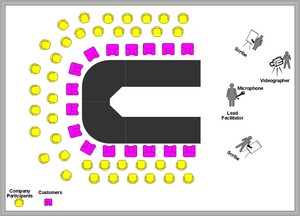Handling the Logistics of a Customer Scenario® Mapping Session
The New CSM Guidebook: Part 2: Logistics Check List
Preparing a customer-facing engagement can be a logistical nightmare. There are subtleties to the logistics details that are required to ensure a smooth and successful customer event. Here we provide a checklist of what is required to run a successful Customer Scenario® Mapping session, which is a superset of all the logistics required for any great customer engagement.
NETTING IT OUT
Planning and preparing a customer-facing engagement, especially customer co-design sessions that include Customer Scenario® Mapping, can be a logistical nightmare. Here we provide a checklist and discussion of the details that go into organizing and setting up these sessions.
Specifically, we look at the logistics that apply to:
- Venue issues
- Incentives for customers
- Supplies and materials
- On-site set up
- Capturing the session
Room Setup for Issues and Vision Discussion
© 2012 Patricia Seybold Group Inc.
1. When having group discussions during a CSM workshop, customers should sit together at the table. If there is room for stakeholders at the table, that’s great—although the customers should be seated all together so it’s easy to pass the microphone during the Issues and Vision Discussion, as well as to differentiate between customers and other participants. Usually, however, there isn’t sufficient room for all at the table, so stakeholders should sit behind the customers where they can actively listen and take notes.
YOUR CSM (OR ANY CUSTOMER-FACING ENGAGEMENT) LOGISTICS CHECKLIST
We work with clients on many different customer-facing engagements—full customer co-design sessions using Customer Scenario® Mapping, Customer Advisory Board meeting, or any other events where you are bringing in customers to interact with your company stakeholders. And every time, we are asked for specific logistics that are required to make the event successful. Even clients who have dedicated event planners leading the charge need advice on special considerations for co-design sessions.
So here are the nitty-gritty logistical details that are required for providing stellar customer engagements. We are presenting all the logistics that apply to a full-on Customer Scenario® Mapping session, since this is the superset of details. If you take out the specifics of preparing for mapping teams, you still have a comprehensive list of logistical details that are so important to avoiding surprises and distractions during the event and that will help ensure the day runs smoothly.
PREPARING THE LOGISTICS OF A CUSTOMER SCENARIO MAPPING SESSION
It takes six to eight weeks (minimum!) to arrange a Customer Scenario® Mapping (CSM) session. A lot of the time is spent doing customer recruitment, interview scheduling, and the interviewing itself (for more information, see "How to Plan for a Customer Scenario® Mapping Session"1). But the logistics also need to start early in order to ensure that things are ready for the customers, partners, and stakeholders who will be coming together to work collaboratively on your future product plans, customer experience, and customer-impacting operations.
Categories of Logistics
Here we provide the pragmatic, and detailed, information on what needs to be done to ensure that the logistics won’t hinder a successful event. The logistics fall into the following categories:
- Venue issues
- Incentives for customers
- Supplies and materials
- On-site set up
- Capturing the session
VENUE ISSUES
Selecting and Confirming a Venue
The first logistics hurdle is to confirm the venue for the meeting. After all, you can’t invite customers to an event if you don’t know when it will be, and you can’t lock in a date unless you have your venue selected and confirmed. When you are doing the mapping sessions at your own facility, you might be able to reserve the appropriate room(s) with little notice, but if you are looking at a public venue, such as a hotel or conference center, it often takes months to find the appropriate space available when you want it. Often, Customer Scenario Mapping events are actually scheduled around space availability!
Note that it’s important to work with an internal or third-party event planner. Internally, that might be an admin who has done meeting planning in the past. Externally, the venue you select typically has an event planner who is assigned to your function. During the session, you will be busy facilitating or participating; you want someone who is in charge of making things run smoothly.
All this might seem like an easy task—just reserving a meeting room at a hotel/conference facility. But CSM has some very specific meeting room requirements...
Sign in to download the full article
0 comments
Be the first one to comment.




